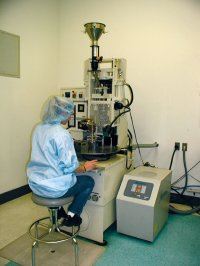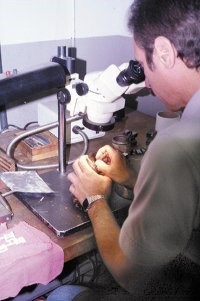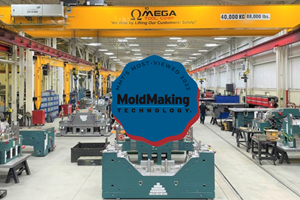Inland Technologies Bucks Trend
A unique mold shop ensures quality, on-time delivery using technology as its key tool.
There is a definite trend gripping the manufacturing landscape today - to stay competitive, customers are more price conscious than in years past, and quality no longer is sought at any cost.
But Inland Technologies (Fontana, CA), a 10-year-old and well-known participant in the plastic injection toolmaking and molding business, is finding a way to save its customers money while improving the quality of their products. And this suits its customers - mostly in the medical industry - just fine.
"More than any other industry, our customers realize that their products must do what they are intended when used by medical workers - they must be reliable and they must be safe for the patients," says Thomas Diaz, manager of engineering and toolroom operations.
He notes that the founders, President Glenn Crossno and Vice President Gary Hengeveld, had a vision to provide the highest quality possible while maintaining their competitive edge in the Southern California injection molding market. That is why Inland Technologies is one of very few companies in the U.S. that houses engi-neering, tooling and cleanroom production all under one roof, eliminating the need to outsource each operation, which is typical for injection molding operations. It also sought and obtained ISO 9001 certification soon after it opened its doors for business in 1992.
Diaz equates quality with efficiency. "The sooner we can deliver the products to our customers without unnecessary delays caused by repeat modifications, the sooner they can get them to market, and the sooner they can reap the financial rewards," he says.
"It's all about technology," he adds. "We adhere to the highest quality standards in the world, resulting in our becoming more efficient in every phase of the process, from the time we receive the order from the customer to when the products are delivered."
This efficiency can be attributed in large part, he says, to the implementation of the latest in CAD/CAM engineering software together with modern injection molding and tooling equipment. To illustrate this fact, Diaz offers a virtual tour of a product from start to finish.
Customer Satisfaction
The customer is Gambro BCT (Lakewood, CO), a market leader in developing a variety of products for the healthcare industry. The product is the Gambro Inlet, a unique new plastic device used to collect and separate plasma and other components of blood used by hospitals, the Red Cross and other medical facilities. Unlike earlier collection methods, this product allows blood to circulate freely while the components are extracted simultaneously, not separately.
The wheels of production are set in motion after the Inland Technologies' management team reviews the project and all the basic questions are answered, among them: What does the job entail? What parts are needed? When are they due? What type of mold is required? How much time to delivery? Once the contract is approved by Gambro, the project is entered into a software program so the job can be tracked every step of the way.
In this case, the job is estimated to take 45 days, but is completed in 33.
First, it goes into the design stage, where Inland Technologies' team of experienced engineers creates a solid model of the mold. Diaz notes that his company only had to make some minor macro and default changes to the original product.
"Within three days, we were able to produce a preliminary mold design, obtain feedback from our engineers and manufacturing technicians who will produce it, and show it to our customer," he notes. "The changes were incorporated into the design and in just one week it was ready for production."
The next step is "detailing," Diaz continues. "First we order the electrode material and mold steel used to produce the mold and core inserts. To get a jump on manufacturing, we obtain everything that will touch the plastic. This allows us to get into the actual meat and potatoes of the job, resulting in quick delivery to the customer." He says that most shops "would still be doing it the old-fashioned way - finishing up all of the drawings and paperwork in the engineering phase."
Solid modeling of the mold's core and cavity follow, along with any modifications called for by the customer in the product database. "We can make the product a more moldable product when the customer can see where our experts want to put the drafts, radii, gates and other elements," Diaz notes. "Similarly, once the solid model is delivered to the customer with our suggestions to make the manufacturing process easier and more efficient, we work closely with the customer's engineering team to modify the design."
Using the newly updated solid modeling data, Inland's programmers create the "cutter paths," or blueprints that allow for the precision manufacturing - from the electrodes, to the CNC milling centers and to the wire EDM, Diaz says.
"Ten years ago no mold shop had one," he comments, referring to the CNC EDM, which can tool 16 electrodes. "It is a fantastic machine. When the electrodes meet the metal, the electric discharge cuts the steel to the precise measurements of the mold."
Another innovation incorporated by Inland Technologies is "mold base standardization," providing maximum production and efficiency. Diaz explains that there are three or four basic sizes of mold presses and a maximum sized mold base that fits into them.
"When we need an 8" by 8" mold base, for instance, it is built exactly like the previous one, except for pockets and water lines. All leader pins, parting line interlocks, support posts and guided ejections will be in the same place. Every time a product has a wide manifold, we already know what size base it will run in, how it is going to be laid out and the size of the cavity blocks," he adds. "This allows us to have the steel already in stock and ready to go, rather than reinvent the wheel each time a similar project arrives."
Production does not begin, however, until Inland and its customers agree to the company's unique Quality Inspection Plan (QIP), says Diaz. This is a thorough review by the company's quality department to ensure that the dimensions required to manufacture the product meet customer specifications. Also determined by QIP are detailed instructions on shipping, inspection, packaging and palletizing.
"For instance," says Diaz, "if the customer wants to add something to the inspection process - a tap size or a counterbore - the QIP is immediately changed to reflect it."
When the Gambro Inlet mold is completed, it is ready to be sent to Inland Technologies' Class 100,000 environmentally controlled cleanroom, where Gambro's new molded product will be created using state-of-the-art hardware and software, including a centralized production tracking system, microprocessor-controlled injection molding machines, microprocessor-con-trolled water supplies and dehumidifying polymer dryers.
A look at the project chart shows the "tool-build," typically an eight-week operation, is ahead of schedule by eight days.
Initially, Diaz notes, 25 molded samples are produced. They are immediately sent to the Quality Control Department where they are inspected to ensure exact compliance with the customer's design specifications, and then forwarded to the customer for approval.
When full production of the Gambro device begins, it undergoes the full QIP inspection process, mandated by ISO 9001 requirements and FDA regulations to guarantee full compliance with the internationally recognized standards for quality.
Quality Is Key
"We monitor production constantly - every hour, every shift," says Hengeveld. "It is par for the course. We believe that product and service excellence derives from precision throughout the design and manufacturing process."
"There is no excuse for compromise on quality in today's manufacturing environment," Crossno adds. "Our customers expect us to deliver their products exactly to their specification, on time and with the highest degree of quality - not only in the product itself, but also in the entire production cycle. That is why they keep coming back."
Related Content
Women Impacting Moldmaking
Honoring female makers, innovators and leaders who are influencing our industry's future.
Read MoreAdvances in P20 Steel Potentially Eliminates Need for Stress Relieving After Rough Cutting
Omega Tool Corp. compares conventional, new P20 grades side by side in production fascia tools, finds no downside.
Read MorePrecision Welding Services Offer Rapid Turnaround Mold Repair and Reduced Molder Downtime
X-Cell Tool & Mold relies on outsourced, high-quality welding repairs from Lewis-Bawol Welding to ensure its customers' molds are back in production quickly and affordably.
Read MoreThe Trifecta of Competitive Toolmaking
Process, technology and people form the foundations of the business philosophy in place at Eifel Mold & Engineering.
Read MoreRead Next
How to Use Continuing Education to Remain Competitive in Moldmaking
Continued training helps moldmakers make tooling decisions and properly use the latest cutting tool to efficiently machine high-quality molds.
Read MoreAre You a Moldmaker Considering 3D Printing? Consider the 3D Printing Workshop at NPE2024
Presentations will cover 3D printing for mold tooling, material innovation, product development, bridge production and full-scale, high-volume additive manufacturing.
Read More


















.jpg;maxWidth=300;quality=90)










